We recently sat down with Kirsten Bryant, PhD, to discuss what motivates her in the lab, hear how mentorship and advocacy have fueled her passion for pancreatic cancer research, and discover why she feels encouraged by progress made in the past decade.
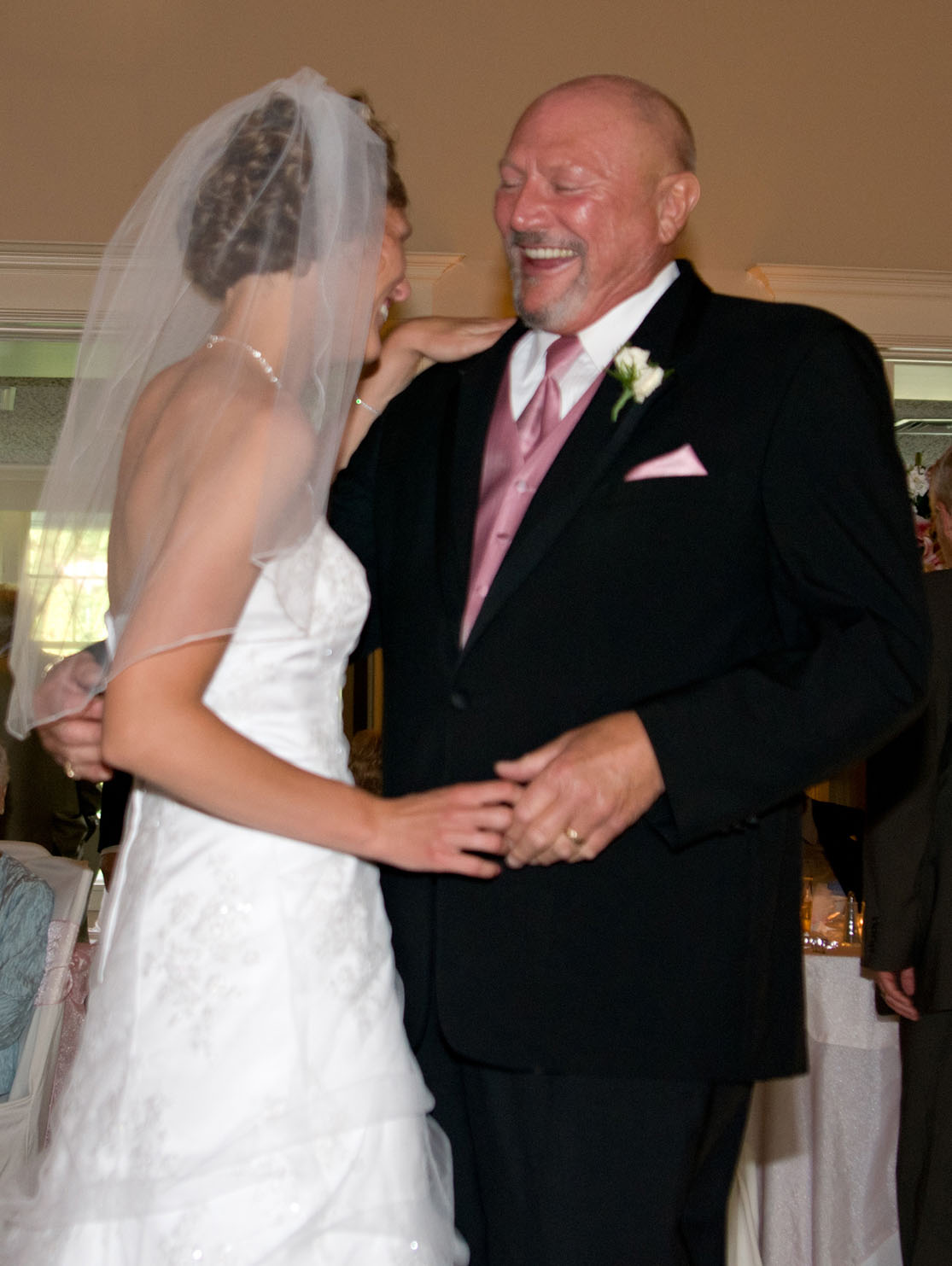
Every cancer researcher is driven by scientific endeavor and the call to help people in need, but for Kirsten Bryant, the roots of the disease run through academic curiosity and into more personal territory. In 2012, Bryant was approaching the end of her doctoral program in Pharmacology at Cornell University and deciding on her postdoc direction when her father was diagnosed with Stage IV pancreatic cancer.
Watching him undergo nearly a year of treatment laid bare for Bryant just how few options existed for patients like her father. “He initially responded to treatment, but then quickly became resistant,” Bryant told us. “In the end he tried a clinical trial and did not respond to it. He wanted so much to keep trying more treatments, but they just didn’t exist.”
Once she’d witnessed firsthand the lack of effective therapies to treat pancreatic cancer, it was clear to Bryant where she would take her career. She wondered for a while if she could read about cancer for the rest of her life, and she knew it would mean heading down a different path than what she had been considering. “But I could see the huge need that we had in the field, and I knew I could make the jump. That’s really what has driven me ever since: trying to find new potential therapies for pancreatic cancer.”
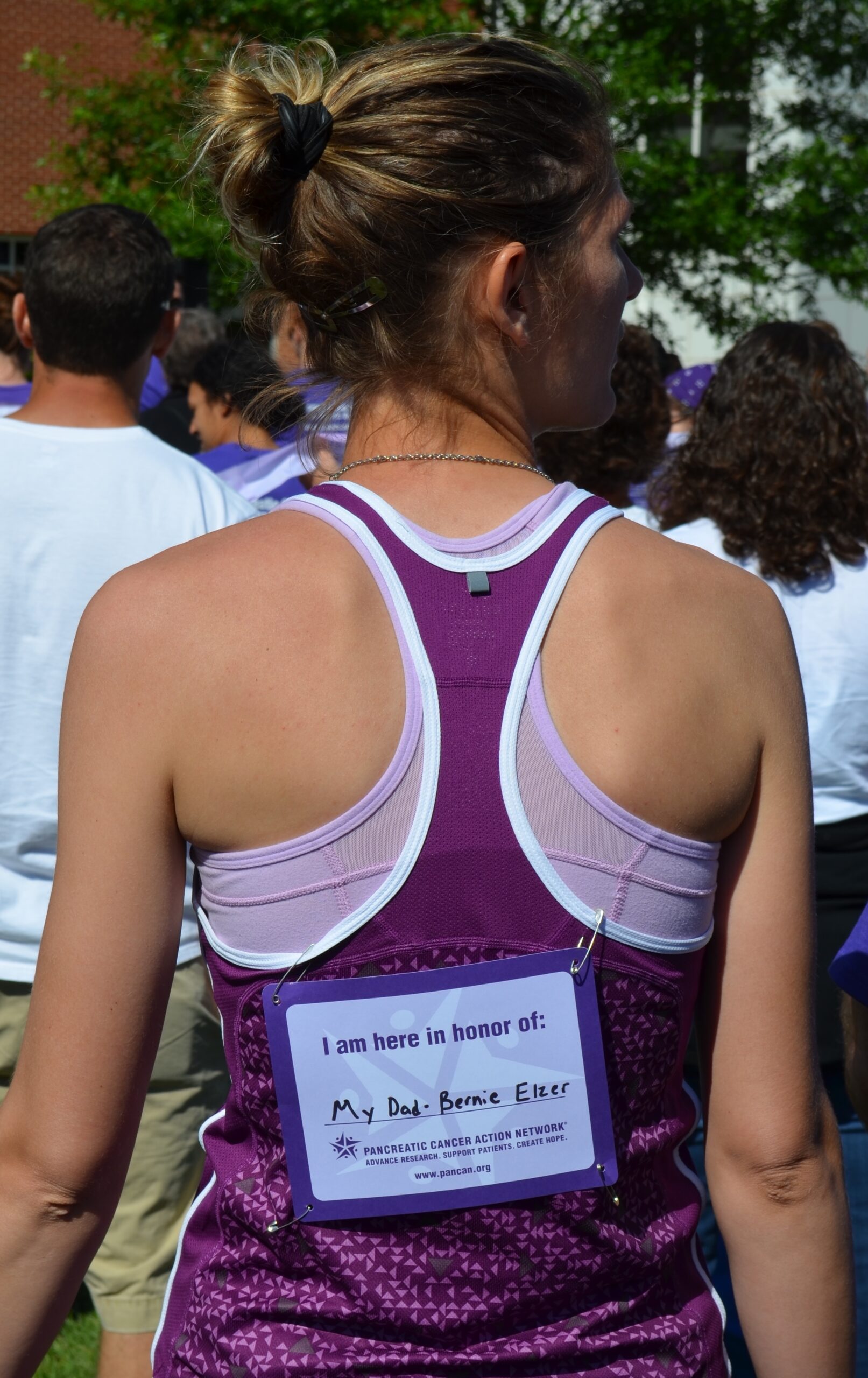
Bryant is now an Assistant Professor of Pharmacology at UNC-Chapel Hill and an integral member of the research team in the Pancreatic Cancer Center of Excellence (PCCE). More than a decade on since joining the UNC Lineberger Comprehensive Cancer Center, she feels proud to have made this deeply personal subject her life’s pursuit.
The Bryant Lab focuses on metabolic activities driving pancreatic tumor growth including autophagy, the process by which cells degrade themselves for fuel. Inhibition of this process has become the focal point of her lab’s research into efficacious treatment of KRAS-mutant pancreatic ductal adenocarcinoma (PDAC).
Bryant’s work is supported by numerous grants and awards, including UNC Lineberger’s 2023 Innovation Award, which she earned with co-investigator John Morris, PhD. Additionally, she and Channing Der, PhD, were 2022 recipients of the Pancreatic Cancer Action Network’s (PanCAN) Therapeutic Accelerator Collaborative Award, a two-year grant worth $340,000 awarded to investigators seeking to understand and enhance the effectiveness of avutometinib and defactinib in combination with the standard regimen for metastatic pancreatic cancer.
Developing cancer therapies requires constant trial and error. New insights can lead you to reroute and reconsider. Are you ever surprised by what turns out to be unexpectedly significant in your projects?
Absolutely, the way my postdoc began is a good example. I came to UNC with an interest in tumor metabolism. Based on the literature at the time, we hypothesized that because PDAC has high levels of autophagy and is driven by RAS in almost all cases, RAS must be driving the high levels of autophagic flux.
Our first experiment was to knock down RAS, and we thought we would see autophagy go away. Instead, we saw the complete opposite. When we knocked down RAS, autophagy was elevated even further. That observation led to about a year of trying to figure out what was wrong with the experiment—what were we missing, why was this happening? A huge part of this is following the science rather than being wedded to a hypothesis. It’s obviously important to do robust research, make sure you do all your controls, but once you have found something, even if it’s not what you expected, you should follow it.
When growing a young lab, you spend so much time on your first finding, but it’s exciting to get to what you envisioned to be the end, and yes, you have one conclusion, but now you five more questions to ask.
How has pancreatic cancer research evolved in the time that you’ve been in the field? Especially having seen this disease from a very personal experience before you’d gained any insight into tackling it, what do you believe has changed?
I was recently thinking about the first pancreas-focused meeting I attended in 2014, the American Association for Cancer Research (AACR) Special Conference on Pancreatic Cancer. There were about 300 scientists at the meeting, and it was a great introduction to the whole field. These big-name scientists whose papers I had read came to my poster to discuss my data, which was less than a year old. Fast forward to 2023, we just had AACR Pancreas in September, and 750 people attended – more than double the original attendance within a decade.
It’s exciting that the field is growing, it’s what we need. There hasn’t been the same focus on pancreatic cancer [as other types] because previously there was just so little known about this disease that a lot of gifted scientists perhaps shied away from studying this really hard to treat cancer. But there’s been a shift over the past decade, we’re bringing more people into the field. And I think it’s that influx of minds that is driving progress. I think this is true for all of science – the more diverse minds you can get thinking about the problems, the more interdisciplinary it is, the more progress you’re going to make.
The pancreatic cancer research community has been extremely nurturing and collaborative, and even as it’s growing it maintains that core group of original scientists and their trainees who have stuck with it. A lot of people who were postdocs with me are now running their own labs and are still studying PDAC. My hope is that this collaborative mentality is maintained because that’s how we’ve made this progress.
Collaborating across disciplines is essential to the PCCE’s research and clinical efforts. How has your work been advanced through collaboration with people outside of your lab and your department?
When my dad was being treated for pancreatic cancer, a landmark paper came out that connected RAS signaling to pancreatic cancer metabolism. That study focused on genetic silencing of KRAS. Fast forward to my postdoctoral work where I focused on proteins downstream of RAS that we had direct inhibitors for. As my study, which focused on pharmacological targeting of the pathway, was developing, I started reaching out to the people who were authors on that landmark paper to see if they saw similar phenotypes with RAS knockdown that I was seeing with downstream inhibitors. And it ended up that they had, and they were willing to contribute unpublished data to my study. Drawing on that network and reaching out to those people was very beneficial for me. Not all fields are like this, and I think it is a real strength of the pancreatic cancer field.
Moving forward to today and the forming of the PCCE, the first thing that excited me was increased communication between clinicians and scientists from many disciplines. I find that having a designated time where we meet and take a moment to think about each other’s research has led to important conversations about what they’re seeing in the clinic and what we’re learning in our labs. The collaborative structure here encourages people to consider how they can work together.
You are an active advocate for patients and their families. What do opportunities for outreach mean to you as both a scientist and as someone who’s been directly impacted by pancreatic cancer?
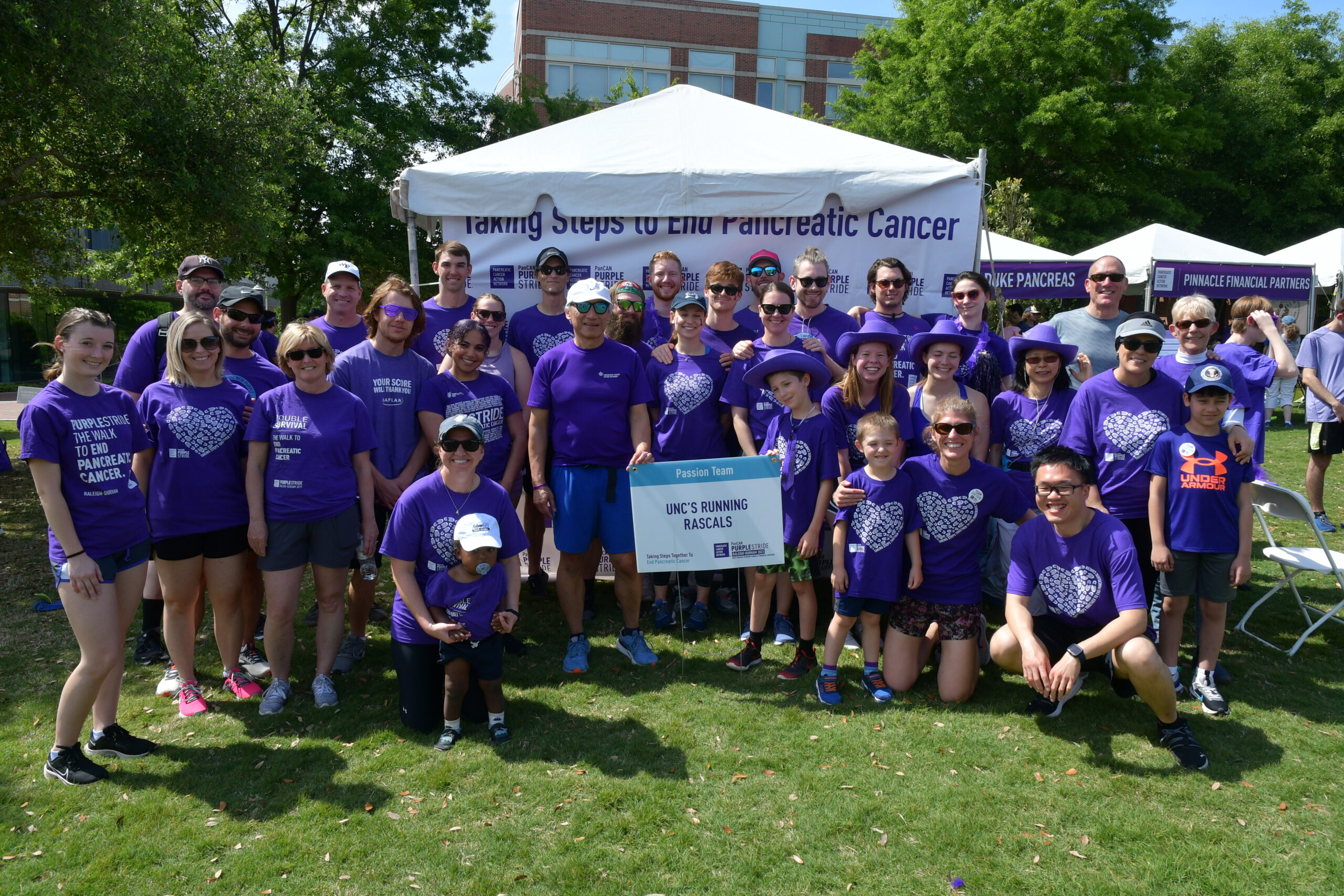
The first thing I became involved with was PanCAN’s PurpleStride, and that was mostly out of grief. I wanted to do something immediately to contribute, in memory of my dad, and Channing, who had spoken at PurpleStride the year before, told me about it. It’s such a moving event, very patient oriented and survivor focused. Because survivors are unfortunately few and far between, they are very much celebrated. There’s a moving opening ceremony, and you have this sea of purple. It makes you realize how many people are affected by this disease. Over time, our lab-based team joined forces with Team UNC and now we run a clinicians-researchers team that has expanded far outside of our own labs, which has been really fulfilling for me.
It was through PurpleStride that I met our PanCAN affiliate. In 2015, I met the family that had organized the local Purple Stride event, and they mentioned that they would really like to see what we do in our lab. One afternoon I gave them a tour of the lab, and they were blown away to see the science being performed. The tours evolved kind of organically into something special. We now have stations themed on different topics, and we can communicate the science in a way that’s easily accessible.
It’s important to me to emphasize to patients and their loved ones just how hard people are working to fight this disease and show what we’re doing with the money they’ve worked so hard to raise. They can see firsthand what the money funds and what we do, but they’re also seeing what makes this so hard. Yes, survival is increasing slower than we’d like, but it is increasing, and here’s what we’re thinking about to push it even further. The feedback we’ve gotten from our lab tours has been so touching, it’s very much appreciated by the community.
What does a typical lab tour consist of?
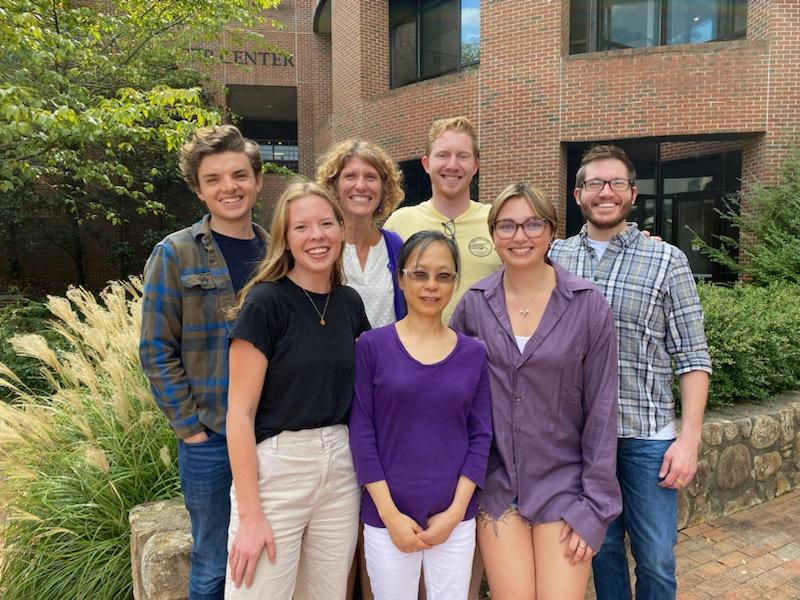
Imagine five to six different stations, each one about 10 to 12 minutes of demonstration and explanation. Each group has a tour guide – a graduate student or postdoc – who walks through the stations with them. At one station, we might have a microscope and a screen that we can project onto. Now, with pancreatic cancer, every patient is different. Our guests know that; they know that where one patient responds to a treatment another might not. So we use this station as a tool to explain heterogeneity. We pull cell lines out of the incubator, put them up on the microscope and simply show how they look different. We can also show very visually that we treat with this drug and this happens in this cell line, but it doesn’t happen in this cell line. This is the basis for heterogeneity. We want to take what they’ve heard in their clinical experience with their loved one and show them a biological reason for it.
I’m always amazed by the questions we get. Patients today have access to so much information. And when it comes to the fundraising, they’ll look around and ask, “How much does this cost, and how much does that cost?” They have in their minds how much their team raised, and they can feel like they added something meaningful to our work. They want so badly to contribute, and I think it’s fulfilling for them to be shown something concrete that they’ve contributed. My mom and my brothers were on the very first tour, so I know firsthand how much it’s appreciated.
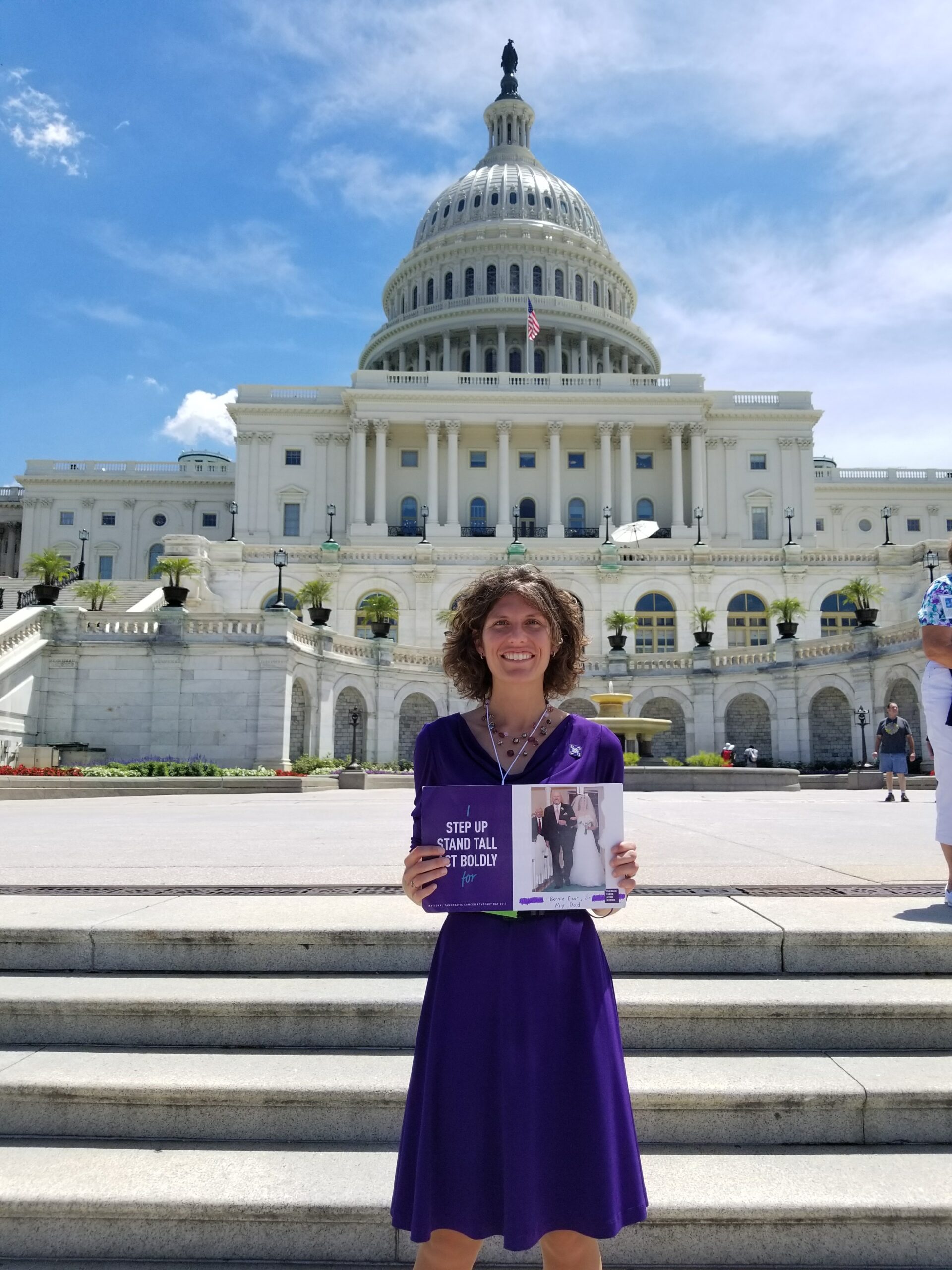
Researchers benefit from being taken under the wings of good mentors. How have mentors impacted your career?
Channing and I have a wonderful working relationship. I credit Channing and Adrienne Cox, PhD, with showing me how I could come at this disease from lots of different fronts. There is the science, yes – they have both been great mentors as far as advising the experiments I should be doing, the group meetings, the revising of papers, etc. – they were hugely helpful with all of that, but then there’s the whole person, right?
It was Channing who told me about PurpleStride as well as another event that the Pancreatic Cancer Action Network hosts, Advocacy Day. Never in my wildest dreams would I have thought that I would go to Capitol Hill to talk to members of Congress about pancreatic cancer research. I almost said no the first time Adrienne told me to do it. But they opened me up to things that they knew I could do that I didn’t know I could.
Now that I have my own students, I’m doing my best to provide the same support. Because I think especially when you’re young, you don’t know everything you’re capable of, and you need that cheerleader to just say, “You can do this,” and push you to a new level when you need it.
Where do you imagine our understanding of this disease will be five years from now? Is it possible to predict what the next piece of the puzzle will be?
This is probably a bit biased, but because I’m a RAS researcher, in the last two years we’ve had our first FDA-approved RAS inhibitors. The first ones were for the G12C mutation, which only occurs in two percent of pancreatic cancer patients. So not many pancreatic patients have been able to benefit from RAS inhibitors yet. But right on the horizon, in preclinical models are G12D inhibitors – that’s 40 percent of our patients – as well as pan-RAS inhibitors.
We already know from lung cancer patients and the small trials that have attempted to treat G12C-mutant pancreatic patients that you can get a response from a RAS inhibitor. You can get tumor shrinkage. But patients acquire resistance, so it’s not the Holy Grail. However, I think having that as a backbone drug is going to open up a number of combination therapies that will be efficacious for patients.
I’m also excited about being able to move the RAS inhibitors into frontline therapy. The only curative option for PDAC remains surgery. If borderline resectable patients could be treated with a RAS inhibitor as frontline treatment and show these dramatic responses we’re seeing initially in metastatic patients, a RAS inhibitor might be able to take a patient who’s not currently a candidate for surgery and make them eligible for surgical intervention.
Overall, I am confident that the more we understand about this disease, the better we’re going to be able to treat it. The first wave was understanding the genomics and the drivers, and I think the next wave will be understanding the complex tumor microenvironment and how the immune system can be harnessed to treat PDAC.
—Tyler Rice, UNC Lineberger Pancreatic Cancer Center of Excellence
